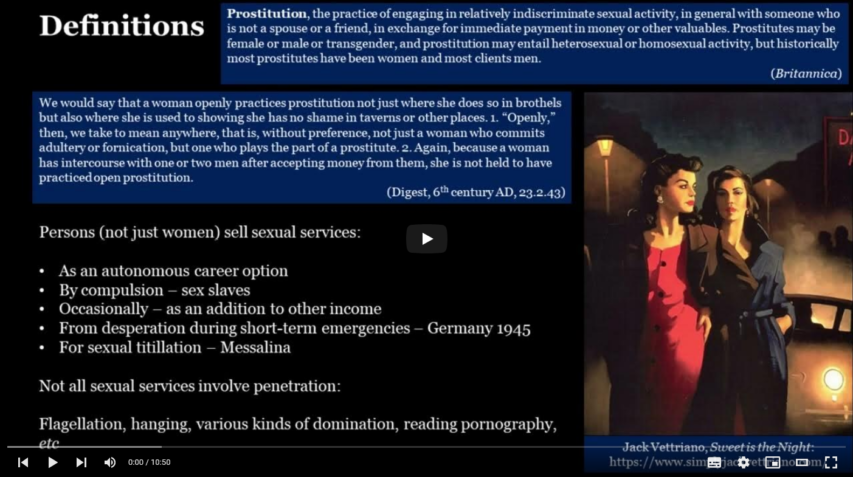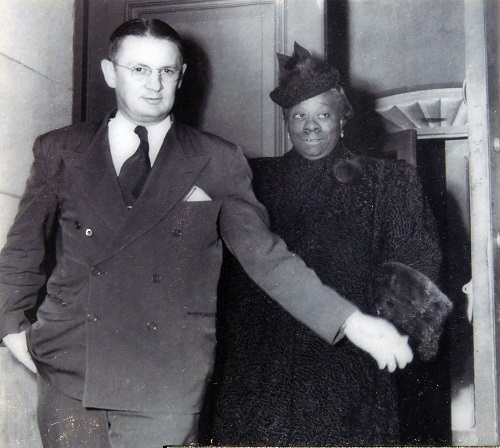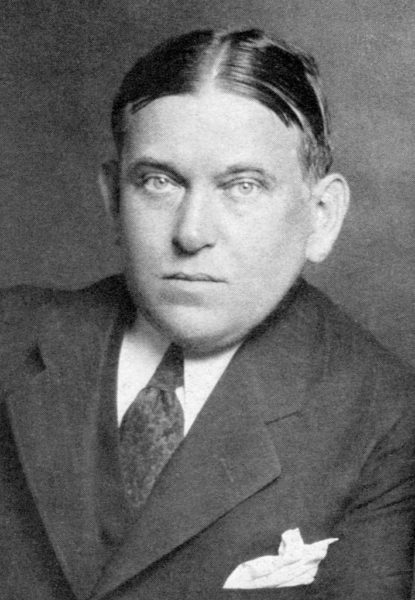History Hit
Published Dec 15, 2023They’re famously thought of as a buttoned up prudish bunch, but we all know they loved to bump uglies as much as anyone today.
Were the spanking punishments of boarding schools really the origins of brothels? Who were the pin-ups of Victorian women? And what did the saucy portrait Queen Victoria gave to Prince Albert look like?
Today we go Betwixt the Victorian Sheets with Dan Snow, from History Hit sister podcast Dan Snow’s History Hit, to find out all about Victorian relationships.
(more…)
April 24, 2024
What Were Victorian Attitudes Towards Sex?
October 17, 2023
QotD: Representations of sex work in SF
Whether they were “Socialators” in Battlestar Galactica, or “Companions” in Firefly, or any number of other euphemisms, one SF trope that seems particularly insidious, especially in movies and TV, more-so than in literature, although it is still prominent there, is turning the world’s oldest profession into something glamorous and honorable, even exalted. I recently had the misfortune to read a book where they took “Make Love, Not War” literally, and all women were drafted at 18 to serve a couple years in a sex corps to keep the peace, under the idea that a free and easy sexual outlet was all it took to quell man’s violent nature. (This was only a background element, not the main focus of the story, but on the other hand, the primary plot about laser light shows being the most highly regarded form of art wasn’t particularly compelling either. And don’t get me started on how unlikable the characters were.)
Maybe it’s a relic from when SF was just another facet of Men’s Adventure magazines, or maybe it’s capitalizing on the stereotypical basement-dwelling Geek’s desire to have high quality women to command at the wave of a few credits or gold pieces. Or, more cynically, it’s the desire of Hollywood producers who actually DO have high quality women at their mercy, career-wise, to further normalize the idea that “Sex work is real work” to help smooth away the resistance to their hamfisted efforts on the casting couch.
TV Tropes has a number of entries about this, from “Unproblematic Prostitution” to “High Class Call Girl”. Writers like to call up the imagery of the Geisha, and make their Space Hookers come across as brilliant sexual artists, with additional talents that help the protagonists, such as advanced degrees or connections to corporate executives and high ranking government officials. (Funny how they are not corporate movers and shakers or government officials themselves …). They forget, of course, that Geisha were not actually prostitutes, and only rarely took lovers. There were still actual brothels in Japan for that sort of thing.
Science Fiction has gotten a lot more difficult to write as the frontiers of reality have pushed back against the flights of fantasy. We have had to accept that you can’t get to the moon inside a Victorian upholstered artillery shell, or set foot on the Jungles of Venus. And maybe that’s why a lot of SF in recent decades has turned towards the softer sciences where theories are more prominent than scientific facts, making it simpler to speculate.
However, even in our understanding of society, there are some realities that can’t be ignored. A few of them are listed in the aforementioned “Unproblematic Prostitution” entry. The primary social reality that undermines all of the tropes is that when you commodify sex, you are putting women on sale. Maybe it’s just fractionally, for a few hours out of her lifetime, but when your fantasy/SF hero comes along and waves a few C-notes to get a woman to do what he wants, it’s not the “Combination of Sex and Capitalism” (“… which are you against?” the excuse goes) but the sublimation of Sex TO Capitalism.
“Sex work is real work,” they like to say, but when you turn sex INTO work, it strips it of all of its better qualities. “Do what you love and you’ll never work another day in your life,” is another lie. I’ve known too many artists who go from having a fun hobby to chasing unsatisfying commissions, eventually burning out from endless requests by cretins for illustrations of their vilest fantasies. So the idea that our happy Space Hookers are having fun and getting paid, and what’s wrong with that, turns into burnout in pretty short order, because the kind of guys who go out looking for “That kind of girl” are not interested in the parts of sex that make it as enjoyable as it is for a compatible couple. They don’t have girlfriends for a reason. So the trope that Prostitution is just Sexy Fun Time falls by the wayside in the face of human nature.
SF also likes to postulate that science will make sex consequence free with perfect contraception and cures for all diseases. Writers and Producers fail to see the actual social costs and secondary effects, some of which we are finally running afoul of today, as women are aging out of their “Hookup culture” days and finding themselves alone and with few prospects for a lasting relationship, while at the same time human reproduction is falling below the replacement rate worldwide. And of course, nature being what it is, there will always be new diseases from new planets or new alien races or who knows WHAT our horny young space cadets have been sticking their dicks into. Human biology has less security in its OS than a Commodore 64.
Dr. Mauser, “Space Hookers Must Die!”, Shoplifting in the Marketplace of Ideas, 2023-07-16.
May 14, 2023
QotD: The original tabloid journalist
Tabloid journalism begins with W.T. Stead, who as editor of the Pall Mall Gazette in the 1880s brought news and scandal to the newly literate masses, transforming public culture and politics with it.
The son of a Congregationalist preacher, Stead grew up in a strict religious household in Northumberland, in a home where theatre was “the Devil’s chapel” and novels “the Devil’s Bible”. Taught to read by his father, the newsman’s nonconformism would inform his campaigns after he moved from the Northern Echo to the Gazette in London.
Stead was most of all famous for the first great newspaper investigation, in 1885, “The Maiden Tribute of Modern Babylon“, on the scandal of child prostitution. Stead had bought a girl called Eliza for £5, on the premise that she was to be taken to a brothel on the continent, using quite dubious methods that got him sent to jail for three months.
Despite this, the story succeeded – a national scandal which led to a change in the law, the age of consent raised from 13 to 16. The idea of English girls being trafficked into sex outraged and horrified the public, Stead’s story imprinted itself deeply into the public psyche, to the extent of influencing George Bernard Shaw’s Pygmalion — thus, Eliza Doolittle.
On the continent it helped to inspire a genre of vaguely pornographic literature about the sexual perversion rife in England, a fantasy that belied the fact that late Victorian London was not a nest of vice, relatively speaking. Most measures of squalor and child abuse had declined in the 19th century and a teenage girl by the end of the century was relatively safe, compared to a predecessor in almost any era; public moral outrage offered protection, even if it could be unforgiving for those same girls who transgressed.
Stead would become the most famous journalist of the era, so renowned that in 1912 he was invited to New York by the US President to attend a conference — and so booked a ticket on a famously unsinkable new liner. He was last seen helping women and children trying to get on to lifeboats, and, true to the chapel ethos of his parents, gave away his lifejacket. He was among the 1,500 who lost their lives on the Titanic.
Ed West, “Our Modern Babylon”, Wrong Side of History, 2023-02-11.
February 13, 2023
Prostitution in the Roman Empire
[Note: This is the introduction to a 95-minute lecture that can only be viewed on YouTube directly due to age restrictions. The link to the full video is here.]
seangabb
Published 13 Dec 2022This lecture is concerned with the customs and institutions of paid sex in the Roman World. The main focus is on the market for paid sex between the founding of the Empire in the last decades before the birth of Christ, down to the establishment of Christianity as the faith of the Empire, with a brief overview of the shifting views of paid sex by the authorities in the Christian Empire. It involves extensive quotation from legal and literary and other contemporary sources, plus modern research and the archaeology, to provide an overview of a subject that if often harrowing and even disgusting, but that is, or should be, a core unit in any history of the Roman World. Subjects covered include:
Sex slaves
“Free” Prostitutes
Forced prostitution
Foundlings as prostitutes
The age of consent in ancient times
The legal status of prostitutes
Violence against prostitutes
Male prostitution
Castration of male sex slaves
The price of sexual services
Brothels
Erotic art
Sexually transmitted diseases
Christianity and prostitutionThere is a full bibliography at the end of both ancient and modern sources.
Note: This lecture deals in an explicit manner with themes that are very controversial and that may give considerable offence. If you believe that you may be offended by any of the images and readings, please do not watch.
(more…)
January 7, 2023
QotD: The “camp followers” of a pre-modern army
It is worth keeping in mind that an army of 10,000 or 20,000 men was, by ancient or medieval standards, a mid-sized town or city moving across the landscape. Just as towns and cities created demand for goods that shaped life around them, so did armies (although they’d have to stay put to create new patterns of agriculture, though armies that did stay put did create new patterns of agriculture, e.g. the Roman limes). Thousands of soldiers demand all sorts of services and often have the money to pay for them and that’s in addition to what the army as an army needs. That in turn is going to mean that the army is followed by a host of non-combatants, be they attached to the soldiers, looking to turn a profit, or compelled to be there.
We can start with sutlers, merchants buying or selling from the soldiers themselves (the Romans called these fellows lixae, but also called other non-soldiers in the camp lixae as well, see Roth (2012), 93-4; they also call them mercatores or negotiatores, merchants). Sutlers could be dealing in a wide array of goods. Even for armies where ration distribution was regular (e.g. the Roman army), sutlers might offer for sale tastier and fancier rations: meat, better alcohol and so on. They might also sell clothing and other goods to soldiers, even military equipment: finding “custom” weapons and armor in the archaeology of military forts and camps is not uncommon. For less regularly rationed armies, sutlers might act as a supplement to irregular systems of food and pay, providing credit to soldiers who purchased rations to make up for logistics shortfalls, to collect when those soldiers were paid. By way of example, the regulations of the Army of Flanders issued in 1596 allowed for three sutlers per 200-man company of troops (Parker, op. cit.), but the actual number was often much higher and of course those sutlers might also have their own assistants, porters, wagons and so on which moved with the army’s camp. Women who performed this role in the modern period are often referred to by the French vivandière.
For some armies there would have been an additional class of sutlers: slave dealers. Enslaved captives were a major component of loot in ancient warfare and Mediterranean military operations into and through the Middle Ages. Armies would abduct locals caught in hostile lands they moved through or enemies captured in battles or sieges; naturally generals did not want to have to manage these poor folks in the long term and so it was convenient if slave-dealer “wholesalers” were present with the army to quickly buy the large numbers of enslaved persons the army might generate (and then handle their transport – which is to say traffic them – to market). In Roman armies this was a regularized process, overseen by the quaestor (an elected treasury official who handled the army’s finances) assigned to each army, who conducted regular auctions in the camp. That of course means that these slave dealers are not only following the army, but are doing so with the necessary apparatus to transport hundreds or even thousands of captives (guards, wagons, porters, etc.).
And then there is the general category of “camp follower”, which covers a wide range of individuals (mostly women) who might move with the camp. The same 1596 regulations that provided for just three sutlers per 200-man Spanish company also provided that there could be three femmes publiques (prostitutes), another “maximum” which must often have been exceeded. But prostitutes were not the only women who might be with an army as it moved; indeed the very same regulations specify that, for propriety’s sake, the femmes publiques would have to work under the “disguise of being washerwomen or something similar” which of course implies a population of actual washerwomen and such who also moved with the army. Depending on training and social norms, soldiers may or may not have been expected to mend their own clothes or cook their own food. Soldiers might also have wives or girlfriends with them (who might in turn have those soldier’s children with them); this was more common with professional long-service armies where the army was home, but must have happened with all armies to one degree or another. Roman soldiers in the imperial period were formally, legally forbidden from marrying, but the evidence for “soldier’s families” in the permanent forts and camps of the Roman Empire is overwhelming.
The tasks women attached to these armies have have performed varied by gender norms and the organization of the logistics system. Early modern gunpowder armies represent some of the broadest range of activities and some of the armies that most relied on women in the camp to do the essential work of maintaining the camp; John Lynn (op. cit., 118-163) refers to the soldiers and their women (a mix of wives, girlfriends and unattached women) collectively as “the campaign community” and it is an apt label when thinking about the army on the march. As Lynn documents, women in the camp washed and mended clothes, nursed the sick and cooked meals, all tasks that were considered at the time inappropriate for men. Those same women might also be engaged in small crafts or in small-scale trade (that is, they might also be sutlers). Finally, as Lynn notes, women who were managing food and clothing seem often to have become logistics managers for their soldiers, guarding moveable property during battles and participating in pillaging in order to scrounge enough food and loot for they and their men to survive. I want to stress that for armies that had large numbers of women in the camp, it was because they were essential to the continued function of the army.
And finally, you have the general category of “servants”. The range of individuals captured by this label is vast. Officers and high status figures often brought either their hired servants or enslaved workers with them. Captains in the aforementioned Army of Flanders seem generally to have had at least four or five servants (called mozos) with them, for instance; higher officers more. But it wasn’t just officers who did this. Indeed, the average company in the Army of Flanders, Parker notes, would have had 20-30 individual soldiers who also had mozos with them; one force of 5,300 Spanish veterans leaving Flanders brought 2,000 such mozos as they left (Parker, op. cit. 151).
Looking at the ancient world, many – possibly most – Greek hoplites in citizen armies seem to have very often brought enslaved servants with them to carry their arms and armor; such enslaved servants are a regular feature of their armies in the sources. The Romans called these enslaved servants in their armies calones; it was a common trope of good generalship to sharply restrict their number, often with limited success. At Arausio we are told there were half as many servants (calonum et lixarum) as soldiers (Liv. Per. 67, on this note Roth (2013), 105), though excessive numbers of calones et lixae was a standard marker of bad general and the Romans did lose badly at Arausio so we ought to take those figures with a grain of salt, as Livy (and his sources) may just be communicating that the generals there were bad. That said, the notion that a very badly led army might have as many non-combatants following it as soldiers is a common one in the ancient sources. And while Roman armies were considered notable in the ancient world for how few camp servants they relied on and thus how much labor and portage was instead done by the soldiers, getting Roman aristocrats to leave their vast enslaved household staff at home was notoriously difficult (e.g. Ps.Caes. BAfr. 54; Dio Cass. 50.11.6). Much like the early modern “campaign community”, our sources frequently treat these calones as part of the army they belonged to, even though they were not soldiers.
Bret Devereaux, “Collections: Logistics, How Did They Do It, Part I: The Problem”, A Collection of Unmitigated Pedantry, 2022-07-15.
June 5, 2022
Odessa Madre, the female Al Capone of Washington DC
In his latest excerpt from the full Weekly Dish, Andrew Sullivan reviews a new book from James Kirchick, Secret City: The Hidden History of Gay Washington, including a fascinating character I’d never heard of until now, a woman who ranked with Al Capone as an underworld boss during Prohibition:
Odessa Madre grew up in a section of Washington DC called Cowtown, because farm animals would occasionally wander its streets. Born in 1907 in abject poverty, she nonetheless lived and thrived in a deeply segregated city as a dark-skinned African-American woman. “There was only three Blacks at Dunbar (High School) back then — I mean Black like me,” she later recalled. “I had good diction, I knew the gestures, but they still made fun of me.” Dess, as many called her, was also a lesbian, and not too shy about it. “I just couldn’t keep no watchamacallit — a man. I guess I was just born to give orders not take them. What kind of man wants a woman like that?”
She went on to become one of the wealthiest African Americans in an overwhelmingly black city — hauling in over $100,000 a year at her peak — by becoming “the female Al Capone”. She ran brothels, pimped women, owned speakeasies, as well as owning a legit and legendary institution on 14th Street, Club Madre. Jamie Kirchick conjures up a scene from the 1940s:
The crowd roared its approval whenever Madre, covered in mink furs and diamonds and trailed by a multiracial retinue of women for sale, entered the premises and sauntered over to the central table, denoted as hers by an ever-present vase holding a dozen long-stemmed roses.
Among the performers at the club: Billie Holiday, Duke Ellington and Count Basie. Madre kept all her illicit businesses alive by the old-fashioned method of bribing the fathomlessly corrupt DC police — “You know I practically ran that damn police department,” she later quipped — and became a renowned mediator of mob disputes across the country.
She also reflects a pattern that occurs throughout Kirchick’s new book, Secret City: The Hidden History of Gay Washington. She is within a core group of lesbians and gay men somehow living their best lives in the mid-20th Century, simultaneously at the center and the periphery of power. They were capable, whip-smart and hard-working, resilient beyond measure, yet never free from the threat of being taken down by the criminal law, exposure, blackmail, violence, public shaming and utter ostracism. Madre was convicted in 1949 on various drug offenses, spent over 13 years in prison on one charge or other, and died in 1990, without a penny to her name. Her corpse stayed in the morgue for a week until someone claimed it.
The same terrible story could be told of countless others. They were powerful until they were powerless. They lived on probation their entire lives.
One of several wonderful things about Kirchick’s book is that it doesn’t condescend to these people, but seeks to understand them on their own terms. It shows the tenacity, nerve, and brilliance of a woman like Madre — as well as her immiseration. It brings to crackling life the many gay men and lesbians who were under persecution so brutal and terrifying it is hard for anyone today to appreciate — and yet they lived, worked, loved and often succeeded. Some details (from the magazine, Washington Confidential) leap out:
Today one can only marvel at the courage demonstrated by the “1700 Negro men, all dressed as women, who held a party on a Potomac River cruise incongruously named the Robert E Lee until it was rudely interrupted ben one hundred police officers.
It’s a rare book about gay people that isn’t burdened by the constrictive dogma of “queer theory” and “intersectionality”, free of the nonsense that the gay rights movement began in 1969. The book treats gay people as complex human beings, not socially constructed victims; and it is unafraid to note how gay men were for long by far the principal targets of American persecution.
March 14, 2022
Roman Republic to Empire 04 Slavery in the Roman Republic and Empire
seangabb
Published 5 Feb 2021[Update 2023-03-02 – Dr. Gabb took down the original posts and re-uploaded them.]
Here is the fourth lecture, which discusses the nature and extent of slavery in the Roman Empire. It begins with legal definitions and the attempted justifications by philosophers, then proceeds, via the use of slaves as workers in all occupations, including as sex objects, to the great slave revolts of the Late Republic. There is also a section on the valuation of slaves.
In this series, Sean Gabb will explain how the Roman Constitution was transformed, in just over a century, from an oligarchical republic with strong elements of democracy to a divine right military dictatorship.
(more…)
January 26, 2022
“Last year, we’re told, was the ‘deadliest’ year for transgender people since records began”
Tish Still, parent of a child who identifies as transgender, was worried about the “epidemic” of trans murder victims:
Facts always matter — but they take on a particular importance when they’re being used to claim that your child could be murdered. So I decided to delve into the research used to inform these claims. For me, it was personal.
The Government doesn’t publish data on the number of transgender people in the UK, though in 2018 it “tentatively” estimated that the figure stood between “approximately 200,000-500,000”. What proportion of that number must have been killed to warrant today’s warnings of trans murder epidemic? 10? 100? 1,000?
To find out, I analysed data collected by the trans-led organisation Transgender Europe, which has received more than a million dollars from the Arcus Foundation, who are based in the US and take a keen interest in transgender issues. As well as donating almost $150,000 to Stonewall, in 2015 the Arcus Foundation handed $312,000 to Transgender Europe specifically to supply reliable global data on transgender murders. The website it created provides an interactive map and links to documents naming the transgender victims.
Looking at Transgender Europe’s list of cases, it became clear — to my relief — that the total murders reported for the United Kingdom since 2008 amounted to 11. This translates as a murder rate of around 0.165%.
Now, that is still significantly higher than the murder rate for the UK as a whole: the ONS reports that the homicide rate in the UK for the year ending March 2020 was 11.7 per million people, rising to 17 per million among men. But look a bit closer at the list of trans murder victims, and that figure of 11 becomes increasingly suspect.
For instance, two of the listed victims, Vikki Thompson and Jacqueline Cowdry, appear to have been erroneously included. Thompson died by suicide while incarcerated in HMP Leeds, while Cowdry’s death was ultimately ruled as non-suspicious. This reduces the total to nine unlawful deaths, all of whom were born male. (By contrast, the number of homicides committed by transgender people between 2008 and 2017 was 12.) For context, the number of women killed by men during the same period was 1800. So much for our alleged “cis-privilege”.
Searching for more information led me to the work of Karen Ingala-Smith, who founded the Counting Dead Women project in 2012 after she realised that there was no central record of the extent of femicide here in the UK; thanks to her, a list of murdered women is read out in the House of Commons each year to imprint the rate of femicide on the minds our political class. Ingala-Smith’s tireless work focusses on female victims of, predominantly, male violence, though she made an exception to highlight the discrepancy between the mass hysteria about transgender victims of homicide compared to the treatment of woman-killing as mere background noise. (There is still no equivalent to the Trans Day of Remembrance for the much greater number of women killed by male violence.)
Crucially, her research sheds a vital spotlight on the nine remaining victims identified by the Trans Murder Monitoring report. Reading it, two things become clear. The first is that it is not entirely certain that all the victims themselves identified with the label “transgender”. The second is that the motives behind these crimes are more complex than straightforward “transphobia”.
July 2, 2021
Japan’s Institutionalization of Rape – WAH 037 – June 1942, Pt. 2
World War Two
Published 1 Jul 2021During the occupation of South-East Asia, Japan builds a large system of institutionalised rape to “keep their soldiers happy”. Meanwhile, Allied refugees from Burma find a safe haven in India, but for some, hardship continues.
(more…)
March 3, 2021
Geishas: World War Two Prostitutes or Entertainers? – WW2 – On the Homefront 007
World War Two
Published 2 Mar 2021The geisha class has long been a feature of Japanese society. In the 1920s, they were caught between the struggle for women’s liberation and the rising sexual demand of powerful men. This crossfire only becomes more intense as war sweeps the Pacific.
Join us on Patreon: https://www.patreon.com/TimeGhostHistory
Or join The TimeGhost Army directly at: https://timeghost.tvFollow WW2 day by day on Instagram @ww2_day_by_day – https://www.instagram.com/ww2_day_by_day
Between 2 Wars: https://www.youtube.com/playlist?list…
Source list: http://bit.ly/WW2sourcesHosted by: Anna Deinhard
Written by: Spartacus Olsson and Fiona Rachel
Director: Astrid Deinhard
Producers: Astrid Deinhard and Spartacus Olsson
Executive Producers: Astrid Deinhard, Indy Neidell, Spartacus Olsson, Bodo Rittenauer
Creative Producer: Maria Kyhle
Post-Production Director: Wieke Kapteijns
Research by: Fiona Rachel
Edited by: Karolina Dołęga
Sound design: Marek KamińskiPortrait Colorizations by:
Mikołaj UchmannSources:
– Metropolitan Museum of Art
– Rijksmuseum
– Narodowe Archiwum Cyfrowe
– Library of Congress
– National Archives NARA
– Nationaal Archief
– The Burns Archive
– Woman and Child in Kimono courtesy of Vintage Japan-esque from Flickr
– Five musicians courtesy of Adolfo FarsariSoundtracks from Epidemic Sound:
– “Paths of a Samurai” – Mandala Dreams
– “Across the Sea of Japan” – Mandala Dreams
– “Secrets Of A Geisha” – Mandala Dreams
– “Watchman” – Yi Nantiro
– “The Unexplored” – Philip Ayers
– “Heavenly Feathers” – Deskant
– “Ode To The Moon” – Joseph Beg
– “Moving to Disturbia” – ExperiaArchive by Screenocean/Reuters https://www.screenocean.com.
A TimeGhost chronological documentary produced by OnLion Entertainment GmbH.
From the comments:
World War Two
17 hours ago (edited)
With this rather dramatic topic, we are happy to revive the On the Homefront series! Considering the popular opinion on geisha in America after the Second World War, it is not surprising at all, that the first association with the word is sex. But when we looked a little further into the topic, it got clearer and clearer that originally the job of a geisha meant no such thing. Still, with the social and political tension of the early 20th century, the job of the geisha evolved further and further to prostitution. This shows once again how the war influenced many different aspects of life and how important it is to shed light on these side stages of the war in order to understand its full impact. What would interest you to know about the different Homefronts of World War II?Cheers, Fiona
January 15, 2021
The Lady Juliana | The 18th-Century All-Women Prison Ship
Weird History
Published 13 Nov 2019A tale as wild as the Seven Seas, the story of the Lady Juliana, a special convict ship full of prisoners sent to Australia, is one of the strangest in the continent’s history. The Lady Juliana had a specific mission: carrying a cargo of female prisoners the British government hoped would help reform the struggling convict colony in New South Wales. This motley crew of British women ultimately had a lasting impact on the history of Australia.
#prisonship #australia #weirdhistory
July 27, 2020
H.L. Mencken
In the latest Libertarian Enterprise, Eric Oppen (with whom I’ve had a few brief email conversations) discusses the work of the “Sage of Baltimore”:
I would say that, on the whole, Mencken is still quite readable and enjoyable, and many of his observations on the American scene are still as valid as when he made them. He has his weaknesses. He’s not much of an historian, which limits him when he takes up historical subjects. He never got over what he saw as the unfair treatment the German cause got in the American press between 1914 and the entry of the US into World War One. He also often identifies people as Jewish or black when it’s not really relevant to what he’s saying, but this was more a custom of his time than out-and-out bigotry. While he often has uncomplimentary things to say about Jews, and blacks, his greatest scorn is reserved for “the lintheads” — his term for the poor whites of the South. He regarded them as barely worthy of human status.
[…] his views on most subjects were quite compatible with libertarian positions. He was an inveterate opponent of government overreaching (which was behind a lot of his ferocious opposition to Prohibition) and while I don’t think he’d approve of drug use, he’d see our War on (Some Unpopular) Drugs as the assault on the Constitution that it is. While he was by no means hostile to blacks, and went out of his way to promote black writers (many of the figures in the “Harlem Renaissance” owed a lot to his support), he’d also denounce affirmative action and our current frenzy of “anti-racism” in scathing terms. His views on the Civil Rights Act of 1964 and how it has been turned into an alternate, and superior, Constitution would probably scorch the paint off the walls.
Mencken’s views on people’s private lives would have infuriated many of his contemporaries. While he disapproved of homosexuality, referring to it negatively in entries in his private diaries, he was by no means a howling “homophobe.” His writings on the travails of Oscar Wilde are very sympathetic to Wilde’s sufferings, which Mencken thought were wholly disproportionate to what he was known to have done. Mencken referred to Lord Alfred Douglas, in a review of Douglas’ book about Wilde, as a Tartuffe — that is to say, a posturing hypocrite.
Having been a reporter for years in Baltimore, back when reporters were very like the old film noir view of them, Mencken was very much a man of the world, and inclined to great tolerance on others’ sex lives. When he wrote of prostitutes, he refrained from the sort of pious moralizing that was expected in his time. He said that prostitutes often actively preferred their profession to other work available to them, and that most of them ended up respectably married. He kept his own love life very private, and was a faithful husband to his wife throughout their brief marriage, but he does mention, here and there, having had other lovers, whom he does not name even in writings designated to come to light only long after everybody involved was dead. By his own account in his Diary, he lost his virginity at age fourteen to a girl of his own age, who had already had other experiences before him. He felt that such experiences, unless pregnancy happened, did no one any harm.
While he was an atheist, Mencken had no particular hostility to religion per se, no matter what the Fundamentalists of his day thought. His book Treatise on the Gods makes interesting reading, although it is marred, in my view, by Mencken’s lack of knowledge of languages. He praises Christianity for having “the most gorgeous poetry,” but as far as I know, he could not read Hebrew, Aramaic or Greek, and was thinking in terms of the King James Bible and the Book of Common Prayer. However, the book is still worth reading, although a serious student of the subject would find it limited.
If you’ve been a regular visitor to the blog, you’ll know I have a huge regard for H.L. Mencken’s work and there are many Mencken quotes that have done duty as QotD entries over the years.
July 18, 2019
The Allied Occupation of Germany After The Treaty of Versailles I THE GREAT WAR July 1919
The Great War
Published on 17 Jul 2019When the Allied armies marched into German territory in late 1918 under the terms of the armistice, they were surprised to see a relatively untouched land. After the signing of the Treaty of Versailles, the Allied Occupation was made permanent and the troops settled in to stay in a country that did not want them there initially.
» SUPPORT THE CHANNEL
Patreon: https://www.patreon.com/thegreatwar
Merchandise: https://shop.spreadshirt.de/thegreatwar/» SOURCES
Leonhard, Jörn. Der überforderte Frieden. Versailles und die Welt 1918-1923 (CH Beck, 2018)
Macmillan, Margaret. The Peacemakers: Six Months that Changed the World (London: John Murray, 2001).
Le Naour, Jean-Yves. La Honte noire (Hachette, 2004).
Schröder, Joachim, Watson, Alexander. “Occupation during and after the War (Germany)” in: 1914-1918-online. International Encyclopedia of the First World War https://encyclopedia.1914-1918-online…
Roos, Julia. “Schwarze Schmach” in: 1914-1918-online. International Encyclopedia of the First World War https://encyclopedia.1914-1918-online…
Godfroid, Anne. “Occupation after the War (Belgium and France)” in: 1914-1918-online. International Encyclopedia of the First World War https://encyclopedia.1914-1918-online…
Pawley, Margaret. The Watch on the Rhine: The Military Occupation of the Rhineland, 1918-1930 (I.B.Tauris, 2007).
Hart, Keith. “A Note on the Military Participation of Siam in WWI.” Journal of the Siam Society (ndp): 133–136.
Lauter, Anna-Monika. Sicherheit und Reparationen. Die französische Öffentlichkeit, der Rhein und die Ruhr (1919-1923) (Essen: Klartext, 2006).
Krugler, Gilles. “Allemagne decembre 1918. Les premières heures de l’occupation“. In Revue historique des armées 254 (2009): 76-81. https://journals.openedition.org/rha/…
Mignon, Nicolas. “Boche, ex-ennemie ou simplement femme? Le point de vue des responsables politiques et militaires sur la question des mariages entre militaires belges et femmes allemandes pendant les occupations de la Rhénanie et de la Ruhr (1918-1929).” In Revue belge de Philologie et d’Histoire (2013) 91-4 : 1259-1283.»CREDITS
Presented by: Jesse Alexander
Written by: Jesse Alexander
Director: Toni Steller & Florian Wittig
Director of Photography: Toni Steller
Sound: Toni Steller
Editing: Toni Steller
Mixing, Mastering & Sound Design: http://above-zero.com
Motion Design: Christian Graef – GRAEFX
Maps: Daniel Kogosov (https://www.patreon.com/Zalezsky)
Research by: Jesse Alexander
Fact checking: Florian WittigChannel Design: Alexander Clark
Original Logo: David van StepholdA Mediakraft Networks Original Channel
Contains licensed material by getty images
All rights reserved – Real Time History GmbH 2019
April 29, 2019
QotD: Prostitution
I had a few patients who were prostitutes. I remember one well-dressed lady in her 40s, whose profession I asked in the course of my history-taking.
“Dominatrix,” she said.
She was obviously very good at it because she had an international clientele, including, for example, a judge in Alabama. She told me that she never went anywhere in her car without her kit, for she might receive an emergency call at any time from Hong Kong or South Africa. You might have thought that being whipped by one woman in black fishnet stockings was as good as being whipped by another, but apparently this was (and I presume still is) not so: It’s the words and gestures that go with the whipping that count as well.
This activity of hers gave her a very good living (her car was far better than mine); she was sending her daughter to private school. I admired her enterprise and thought of Sor Juana Inés de la Cruz. Was she or the judge in Alabama to blame? Was either of them to blame at all?
Of course, she wasn’t typical of the profession, and hard cases, as they say, make bad law. But I am not at all sure that I saw the poor prostitutes in my street as merely victims, as the new French law would have them. Not everyone with their life history becomes a crack-taking prostitute. This does not mean that I did not pity them for what they had become. If we can truly sympathize only with those who have done nothing to contribute to their own fate, we shall have very restricted sympathies indeed.
Theodore Dalrymple, “Turning Tricks Into Sympathy”, Taki’s Magazine, 2016-04-09.
November 18, 2018
The Toronto Circus Riot of 1855
The History Guy: History Deserves to Be Remembered
Published on 26 Oct 2018In 1855 Toronto, a fireman and a clown walked into a brothel. What followed would change the course of one of the world’s great cities.
The episode is intended for educational purposes. All events are portrayed in historical context. No graphic depictions of violence are included.
The History Guy uses media that are in the public domain. As photographs of actual events are sometimes not available, photographs of similar objects and events are used for illustration.
Patreon: https://www.patreon.com/TheHistoryGuy
The History Guy: History Deserves to Be Remembered is the place to find short snippets of forgotten history from five to fifteen minutes long. If you like history too, this is the channel for you.










